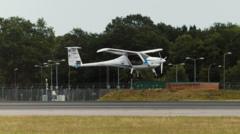Is Electric Flight the Future? First Landing at Gatwick Airport!

The Landmark Event of Electric Flight at Gatwick Airport
This week marks a significant milestone in aviation history as the first-ever electric flight touched down at Gatwick Airport. The Pipistrel Velis Electro, a two-seater electric aircraft, is currently on a 17-day tour around France, making a stop at one of the UK’s busiest airports. This development not only highlights the growing interest in sustainable aviation but also signifies a shift towards a greener future for air travel. With Gatwick Airport at the forefront of this movement, the implications for the aviation industry could be profound.
Understanding the Pipistrel Velis Electro
The Pipistrel Velis Electro is a unique aircraft that brings together innovative technology and eco-friendliness. Here are some key features:
- Electric Powertrain: The Velis Electro is powered entirely by electric motors, which eliminates the reliance on fossil fuels and significantly reduces carbon emissions.
- Two-Seater Capacity: Designed for both training and commercial use, this aircraft can comfortably accommodate a pilot and one passenger.
- Flight Operations: Approved for pilot training and various operational tasks, making it a versatile choice for flight schools and aviation enthusiasts.
- Noise Reduction: The electric motors produce less noise compared to traditional combustion engines, contributing to a quieter flying experience.
The Journey to Gatwick Airport
The Velis Electro’s journey is not just a promotional tour; it serves as a proof of concept for the viability of electric aircraft in everyday aviation. Gatwick Airport’s CEO, Mark Johnston, expressed pride in facilitating this historic flight, emphasizing the airport's commitment to sustainable practices. The visit aligns with broader efforts to decarbonize the aviation sector, showcasing how innovation can reduce environmental impact.
Gatwick's Commitment to Sustainability
Gatwick Airport has taken significant steps towards reducing its carbon footprint. This includes:
- Decarbonization Program: The airport has initiated a £250 million decarbonization program aimed at achieving net-zero emissions for its own operations.
- Introduction of Electric Vehicles: As part of this initiative, Gatwick is incorporating 47 new electric vehicles into its airside operations, which includes engineering and support vehicles.
- Future Fleet Plans: The airport’s long-term goal includes upgrading its entire fleet of 300 vehicles to fully electric by 2030.
The Implications of Electric Flight on the Aviation Industry
The arrival of electric aircraft like the Velis Electro could have far-reaching implications for the aviation industry. Here are some of the potential impacts:
1. Reduced Carbon Emissions
Electric flights promise a substantial reduction in greenhouse gas emissions. As the industry seeks to address climate change, transitioning to electric power can play a crucial role in minimizing aviation's carbon footprint.
2. Lower Operating Costs
Electric aircraft often have lower operating costs compared to traditional planes due to reduced fuel expenses and lower maintenance requirements. This could lead to more affordable air travel options.
3. Enhanced Training Opportunities
With the Velis Electro approved for pilot training, flight schools can introduce students to electric aviation, fostering a new generation of pilots skilled in operating sustainable aircraft.
4. Innovations in Aircraft Design
The success of electric flights may spur further innovations in aircraft design. The aviation industry could see more developments in aerodynamics, battery technology, and materials science, leading to even more efficient flying machines.
Challenges to Overcome
Despite the promising outlook for electric aviation, several challenges remain:
1. Battery Technology
Current battery technology limits the range and payload capacity of electric aircraft. Continued advancements in energy storage solutions are crucial for broader adoption.
2. Infrastructure Development
The need for charging infrastructure at airports and in-flight charging capabilities must be addressed to facilitate the widespread use of electric aircraft.
3. Regulatory Framework
As electric aviation is a relatively new field, regulatory bodies must develop guidelines and standards that address safety, performance, and operational protocols for electric flights.
Looking Ahead: The Future of Electric Aviation
The successful landing of the Pipistrel Velis Electro at Gatwick Airport serves as a beacon of hope for the future of sustainable aviation. As the world grapples with the effects of climate change, the aviation industry has a vital role to play in adopting greener practices. The interest in electric aircraft could catalyze further innovations, investment, and collaboration among stakeholders in the aviation ecosystem.
Conclusion: The Path Forward
As we look to the future, the integration of electric aircraft into mainstream aviation is not just a possibility; it is becoming an imperative. Airports like Gatwick are paving the way for a sustainable future, aligning their operations with global efforts to combat climate change. The electric flight initiative is a promising step towards reducing the aviation sector’s environmental impact, and it is exciting to consider what the future holds for air travel.
FAQs About Electric Flight and Aviation Sustainability
What is the Pipistrel Velis Electro?
The Pipistrel Velis Electro is a two-seater electric aircraft that is designed for pilot training and commercial operations, characterized by its eco-friendly electric powertrain.
How does electric flight reduce carbon emissions?
Electric flights produce zero emissions during operation, significantly reducing the overall carbon footprint of air travel, especially when powered by renewable energy sources.
What are the challenges facing electric aviation?
Key challenges include advancements in battery technology, the development of necessary infrastructure, and the establishment of regulatory frameworks to ensure safety and performance.
How can airports contribute to sustainable aviation?
Airports can adopt electric vehicles for ground operations, invest in renewable energy sources, and facilitate infrastructure for electric aircraft to support a sustainable aviation ecosystem.
The successful landing of the Pipistrel Velis Electro at Gatwick Airport is only the beginning of a revolutionary shift towards sustainable aviation. As the industry embraces electric flight, we stand at the cusp of a new era in air travel. How do you envision the future of aviation in a world focused on sustainability? #ElectricFlight #SustainableAviation #GatwickAirport
Published: 2025-07-12 10:49:30 | Category: technology



